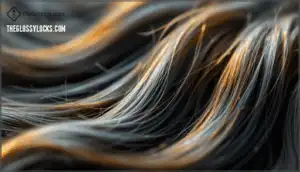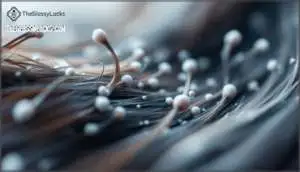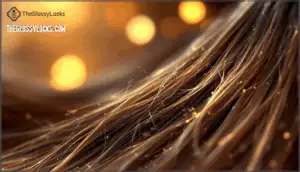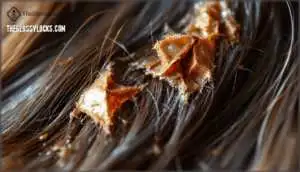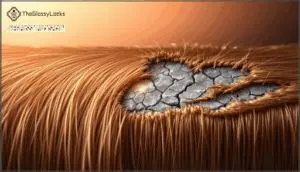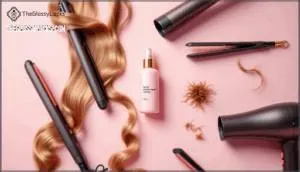This site is supported by our readers. We may earn a commission, at no cost to you, if you purchase through links.
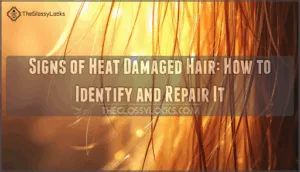
Heat styling doesn’t announce itself with dramatic breakage right away. Instead, it leaves subtle markers that many dismiss as "just needing a trim" or "bad hair days." The difference between reversible dryness and permanent damage often comes down to catching the signs early, and most people miss the initial red flags entirely.
Your hair is already telling you what’s happening—you just need to know which changes matter and which ones signal it’s time to change your routine before the damage becomes irreversible.
Table Of Contents
Key Takeaways
- Heat damage accumulates gradually through protein bond restructuring at temperatures above 300°F, often appearing as subtle changes in texture and shine before progressing to irreversible breakage if early warning signs are ignored.
- The most reliable indicators of heat damage include loss of elasticity (strands snap instead of stretching), increased porosity (hair absorbs moisture quickly but can’t retain it), rough texture changes, and persistent frizz that won’t respond to products.
- Prevention requires matching tool temperatures to your hair type (250-300°F for fine hair, up to 410°F maximum for thick hair), always applying heat protectant on damp hair before styling, and reducing styling frequency by incorporating heatless alternatives.
- Repair focuses on damage management rather than reversal—regular trims every six to eight weeks prevent split ends from traveling upward, while weekly deep conditioning masks with keratin and natural oils restore moisture to compromised strands over a three to six month recovery period.
What Causes Heat Damaged Hair?
Heat damage doesn’t happen by accident—it’s usually the result of habits you mightn’t realize are harmful. Understanding what’s behind the damage is the first step to protecting your hair.
Let’s look at the main culprits that cause heat damage in the first place.
Frequent Use of Hot Styling Tools
Using your flat iron or curling wand day after day might seem harmless, but each pass with heat strips away a little more moisture from your hair strands, leaving them parched and vulnerable.
Daily heat styling disrupts your hair’s hydration balance, breaking down protective barriers that lock in moisture. Without a heat protectant, styling technique impact multiplies, and signs of heat damaged hair appear faster than you’d expect.
High Temperatures and Poor Tool Quality
Cranking your tools up to maximum heat or relying on a cheap flat iron you picked up at a drugstore years ago can inflict damage that goes far beyond what frequency alone creates. High heat at temperatures exceeding 400°F permanently alters your hair’s structure, while low-quality tools with poor heat distribution create hot spots that scorch some strands and leave others untouched.
Technology improvements in modern styling tools, including ceramic and tourmaline materials, guarantee even temperature impact across your hair, reducing signs of heat damaged hair like split ends and breakage that cheaper options cause.
Styling Wet or Damp Hair
When you run a flat iron or curling wand over hair that’s still holding water, you’re basically steaming your strands from the inside out, causing damage that’s both instant and severe. Water trapped inside the hair shaft boils under high heat, creating microscopic bubbles that fracture your hair’s structure and compromise hair elasticity.
Heat styling wet hair steams your strands from within, boiling trapped water into microscopic bubbles that fracture the structure and cause instant, severe damage
This heat styling mistake is preventable through proper drying techniques—blow-dry completely or air-dry before heat styling, then apply a heat protectant for double protection against this common cause of heat damage.
Hair Type and Previous Chemical Treatments
Your hair type and any chemical treatments you’ve had play a huge role in how vulnerable you’re to heat styling damage. Asian hair shows statistically higher protein loss from heat compared to Caucasian hair, while Afro-textured hair experiences greater cuticle damage due to naturally higher hair porosity.
If you’ve bleached, dyed, or chemically relaxed your strands, you’re working with chemically treated hair that’s already compromised—bleaching alone can slash tensile strength by 45%, making your hair texture far more susceptible to heat-induced breakage and moisture loss. Overuse of styling tools can lead to significant hair breakage.
Key Signs of Heat Damaged Hair
Heat damage doesn’t always announce itself with a dramatic hair disaster. Instead, it shows up gradually through specific warning signs that are easy to miss if you don’t know what to look for.
Here are the key indicators that heat styling has taken a toll on your hair.
Dryness and Loss of Shine
One of the first things you’ll notice when heat damage sets in is that your hair loses its natural luster, feeling dry and looking dull instead of vibrant and smooth. This happens because high temperatures compromise cuticle integrity, preventing your strands from reflecting light properly.
Heat also depletes natural oils and disrupts hydration levels, leaving hair dehydrated and parched. Environmental factors and product buildup can worsen the dryness, making dullness even more noticeable.
Split Ends and White Nodules
As your hair weakens, you’ll likely spot frayed ends that split in two or more directions, and if you look closely, you might even notice small white nodules clinging to the tips—both telltale markers that heat has pushed your strands past their breaking point.
These nodules form when the hair shaft splinters completely, creating tiny knots that signal severe damage.
Regular trims every six to eight weeks help prevent splits from traveling upward, keeping your hair healthier and stopping further breakage before it spreads.
Breakage and Increased Shedding
When heat styling takes too much of a toll, you won’t just see damage at the ends—your hair will start snapping off mid-strand, leaving you with shorter, uneven pieces that shed far more than the typical 50 to 100 strands a day. This breakage reduces your hair’s overall density, making ponytails look thinner and disrupting your natural growth cycle.
Repairing heat-damaged hair requires cutting back on hot tools and focusing on moisture-rich treatments that strengthen weakened strands from within.
Frizziness and Persistent Flyaways
If you’ve noticed your hair standing up in all directions, refusing to lie flat no matter how much product you smooth on, that’s heat damage announcing itself through constant frizz and flyaways that seem to have a mind of their own.
Heat-damaged hair becomes more porous, meaning humidity slips in easily and disrupts your style within minutes. Static electricity clings to these weakened strands, creating those stubborn flyaways that make your hair look unpolished and difficult to manage.
Changed or Rough Hair Texture
Your hair used to feel soft and smooth, but now running your fingers through it feels more like brushing against sandpaper—that’s texture change, one of the clearest red flags that heat has rewritten your hair’s natural structure.
Heat alters keratin proteins in the cortex, turning strands coarse and stringy. These hair texture changes are signs of damaged hair that won’t improve without repairing texture through moisture-focused treatments and prevention tips like lowering tool temperatures.
How Heat Damage Affects Hair Structure
Heat damage doesn’t just affect how your hair looks—it changes its structure from the inside out. When you expose your strands to high temperatures repeatedly, the proteins and layers that give hair its strength start to break down.
Understanding what’s happening beneath the surface helps you recognize the damage early and take steps to fix it.
Cuticle and Cortex Damage
Think of your hair strands like a shingled roof: when those protective layers start to crack and peel, everything underneath becomes vulnerable. Cuticle damage from heat styling exposes the cortex, and that’s when you’ll notice real structural consequences that go beyond surface-level issues.
Here’s what happens to your hair structure under repeated heat exposure:
- Cuticle degradation begins with tiny cracks and lifted scales, eventually fragmenting the protective outer layer that keeps your hair smooth and shiny
- Cortex denaturation occurs when temperatures above 200°C break down the keratin proteins inside each strand, fundamentally altering your hair’s integrity
- Moisture loss accelerates as damaged cuticles can no longer seal in hydration, reducing water content by up to 40% compared to healthy hair
- Surface morphology changes as roughened, chipped cuticle edges increase friction between strands, making your hair tangle and snag during brushing
- Hair cuticle damage combined with cortex breakdown creates a weakened structure that’s prone to breakage, with tensile strength dropping by as much as 60%
Once the cuticle’s protective barrier fails and the cortex deteriorates, your hair can’t bounce back on its own. Using a hair mask can help with repairing damaged hair.
Loss of Elasticity and Stretch
Healthy hair should bounce back when you gently stretch it, but once heat damage sets in, that natural elasticity disappears and your strands snap like dried-out rubber bands instead. Mechanical testing reveals that repeated heat exposure causes protein damage that reduces hair recoil by up to 60%, making elasticity testing a reliable way to spot heat damaged hair.
When moisture balance is compromised and hair banding occurs during stretching, your strands have lost their structural integrity and need targeted hair repair treatments to restore flexibility.
Increased Hair Porosity
When you lose elasticity, another problem emerges: heat-damaged hair becomes increasingly porous, making your cuticle structure more vulnerable and unstable. Increased hair porosity means your strands absorb moisture rapidly but lose it just as fast, creating a frustrating cycle of dryness that signals serious cuticle damage.
- Moisture absorption happens quickly, with damaged strands sinking immediately in water tests
- Moisture loss accelerates, reducing water retention by up to 40% after heat exposure
- Chemical penetration deepens, allowing dyes and treatments to absorb three times faster than healthy hair
- Diagnostic testing confirms porosity issues when clients report persistent frizz and rapid color fading
This compromised barrier makes hair damage repair more challenging and increases vulnerability during future styling sessions.
Poor Color Retention and Fading
That porous, weakened structure doesn’t just struggle with moisture—it won’t retain your color either, leaving dyed or treated hair looking washed-out and dull within weeks of your salon visit.
Heat impacts color by breaking down the cuticle’s protective barrier, which allows pigment molecules to escape faster during washing and UV exposure.
Hair color fading accelerates with heat-damaged hair because the compromised structure can’t lock in color treatment pigments, so even high-quality color products won’t last as long without proper hair damage repair.
Preventing Heat Damage to Your Hair
The good news is that heat damage doesn’t have to be inevitable. You can protect your hair and keep it healthy with a few smart changes to your styling routine.
Here’s what actually works when you’re trying to prevent heat damage before it starts.
Reducing Heat Styling Frequency
One of the simplest ways to protect your hair from heat damage is to give your strands a break and cut back on how often you reach for styling tools.
Try a gradual reduction in your heat styling routine by incorporating heatless hairstyles like braids, buns, or twist-outs that embrace texture naturally. Air drying and minimalist styling approaches can help ease the shift while preventing heat damage.
Choosing Safe Temperatures and Tools
Beyond cutting back on hot tools, choosing the right heat styling tools and temperature settings makes all the difference in preventing heat damage. Quality ceramic vs titanium plates distribute heat evenly, while adjustable controls let you dial down the risk.
Here’s how to style smarter and safer:
- Match temperature to your hair type: Fine or damaged hair needs 250°F–300°F, normal hair 300°F–375°F, and thick hair up to 410°F, but trichologists recommend staying below 365°F.
- Choose ceramic tools for even heating: They reduce hot spots and preserve shine better than titanium, which suits only coarse hair.
- Inspect tools regularly for tool maintenance: Check cords, plates, and auto shut-off features to prevent overheating and burn prevention incidents.
- Look for professional compliance standards: Quality tools meet safety regulations, lowering risks of electrical issues and accidental burns.
- Use the lowest effective setting: Higher heat doesn’t mean better results—it just means more damage and rough texture down the line.
Using Heat Protectant Sprays
If you’re still reaching for your flat iron or curling wand without prepping first, you’re practically rolling out the red carpet for heat damage.
A heat protectant spray creates a barrier between your hair and heat styling tools, locking in moisture and preventing protein breakdown. Look for products with silicones or natural oils—application techniques matter, so mist evenly on damp hair before drying to shield every strand from temperatures that cause hair repair nightmares.
Adopting Gentle Styling Techniques
Even when you’ve locked down your heat protectant routine, the way you actually wield your styling tools can make or break your hair’s integrity. Gentle hair care means embracing heatless hairstyles and smart heat styling techniques that respect your strands.
- Air Drying reduces heat exposure and maintains natural moisture levels
- Braiding Methods create waves without subjecting hair to damaging temperatures
- Silk Scarves protect hair overnight while setting styles gently
- Wide Combs detangle without breakage, unlike narrow-toothed brushes
- Protective Styles minimize manipulation and shield vulnerable ends from heat damage
Repairing and Treating Heat Damaged Hair
Once you’ve spotted the signs of heat damage, the good news is that you can take steps to bring your hair back to life. While you can’t reverse the damage completely, you can improve your hair’s condition and prevent further harm.
Let’s look at three effective ways to repair and treat heat damaged hair.
Moisturizing and Restorative Hair Masks
Hair masks work like intensive therapy sessions for damaged strands, delivering concentrated moisture and restorative treatment deep into the cuticle. Look for mask ingredients like argan oil, hydrolyzed keratin, and glycerin—these powerhouses appear in over 75% of commercial products for good reason.
You’ll want to apply them every one to two weeks, leaving the formula on for 10 to 20 minutes to increase hydration. Market trends show growing user satisfaction, with 89% rating moisturizing masks highly for addressing heat-damaged hair.
Regular Trims and Split End Removal
Split ends don’t heal themselves, which means the only real fix is cutting them off before they travel up the hair shaft and cause more damage. Most stylists recommend scheduling trims every six to eight weeks to prevent split ends from turning into major breakage. Regular cutting techniques remove damaged ends and keep hair damage from spreading upward.
Why trimming matters for heat damaged hair:
- Prevents breakage from worsening – Split end types like feathering and tree splits continue climbing up strands if left untreated
- Home trimming works between appointments – Use sharp scissors to snip visible splits, but save major cuts for professionals
- Professional benefits include precision – Stylists assess trim frequency based on your heat styling habits and damage level
- Healthier growth follows removal – Cutting away compromised ends lets you focus treatments on repairable sections
Building a Healthy Hair Care Routine
Treating heat damage isn’t a one-time fix—it’s about building daily habits that protect your hair from the inside out while helping it recover from past styling stress. A consistent routine focused on hydration and scalp health gives heat-damaged hair the foundation it needs to rebuild strength and regain its natural texture.
Repairing damaged hair takes patience, but gentle products and protective practices make the difference between slow recovery and ongoing breakage.
| Routine Element | How It Helps Heat Damaged Hair |
|---|---|
| Sulfate-free shampoo | Preserves natural oils without stripping moisture from already compromised strands |
| Weekly deep conditioning | Delivers intensive hydration that penetrates damaged cuticles and restores elasticity |
| Heat protectant (every time) | Creates a barrier between styling tools and hair treatment products already working to repair damage |
| Protective styles between washes | Reduces mechanical stress and gives hair care routine time to work without daily manipulation |
Frequently Asked Questions (FAQs)
Can heat damaged hair return to normal naturally?
Unfortunately, natural repair won’t fix damaged hair—once heat breaks hair’s structure, affecting hair elasticity and causing hair breakage, those strands can’t regenerate. However, your hair’s regenerative capacity means new growth emerges healthy.
Damage severity matters, as lifestyle impacts recovery and determines restoring damaged hair timelines.
How long does it take to recover from heat damage?
Recovery time varies based on damage severity, hair porosity, and treatment efficacy. With regimen consistency and realistic expectations, repairing damaged hair takes three to six months.
Restoring damaged hair requires proper heat damaged hair treatment methods and commitment to hair health and care.
What temperature is safe for heat styling tools?
Think of your flat iron like a stovetop—medium heat cooks without burning. For most hair types, 300-350°F is safe.
Fine or damaged hair needs lower temperatures, around 250-300°F, while thick or coarse hair can tolerate up to 400°F with heat protectant.
Does air drying prevent all heat damage completely?
Air drying risks exist through prolonged drying time effects, which can increase hair porosity impact and product buildup risk. Complete damage prevention isn’t guaranteed—heat damage from styling tools is avoided, but other hair damage sources remain.
Conclusion
Your hair speaks before it breaks—those subtle shifts in texture, shine, and manageability are distress signals worth decoding. Catching the signs of heat-damaged hair early transforms what could be permanent structural changes into manageable repair work.
You’ve already invested time in styling; now invest equal attention in listening to what your strands are telling you. The healthiest hair isn’t about avoiding heat entirely—it’s about respecting the fine line between transformation and destruction, and adjusting your routine the moment that balance tips.
- https://pmc.ncbi.nlm.nih.gov/articles/PMC3229938/
- https://www.bohrium.com/paper-details/establishment-of-heat-damaged-model-for-hair/1157409234560745478-5721
- https://www.dyson.com/discover/insights/hair/health/how-does-heat-damage-hair
- https://need-hair.com/too-hot-to-handle-the-damage-heat-does-to-hair/
- https://en.wikipedia.org/wiki/Cortex_(hair)

